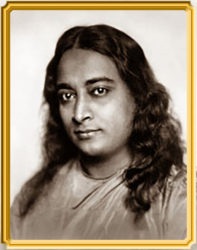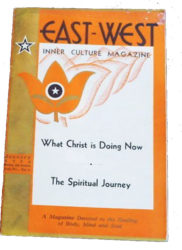
“After repentance, it is necessary to believe
in the Gospel, or “God’ spell,”
or God’s pronouncement of Truth,
through the meditative intuition of the devotee.”
Dear devotee, Here you will find the early Bible commentaries which Yogananda published in his magazines as articles, from 1932 onwards. They have historical, vibrational, and inspirational value, but the Master didn’t consider them a final product, as they still required careful editing. Tara Mata, his editor-in-chief, was absent from his ashram from 1929-1936. Later she worked on these commentaries thoroughly, to give them the precious luster they deserve. In addition, the Master himself revised his early interpretations during the final years of his life.
So what you will find here is simply meant for devotees who are curious about the first raw material which Yogananda published in the early years. It is a small portion of it: his Bible commentaries printed in only two years, from 1932-1934.
A little historical background
One major part of Yogananda’s mission in the West was to bring back the original Christianity of Jesus Christ. Therefore in 1932 he started to offer his divinely inspired Bible interpretations, in his East-West magazine, side by side with his Bhagavad Gita commentaries. For 20 years these articles appeared regularly under the heading The Second Coming of Christ.
 In the Autobiography of a Yogi (1951) he informed his readers in a footnote that his Bible interpretations could be found in his magazines: “Currently appearing in Self-Realization Magazine (formerly East-West).”
In the Autobiography of a Yogi (1951) he informed his readers in a footnote that his Bible interpretations could be found in his magazines: “Currently appearing in Self-Realization Magazine (formerly East-West).”
The creation of a book
Just like with his Bhagavad Gita interpretations, toward the end of Yogananda’s life his hope was to get his Bible commentaries published in book form, in order to reach the entire world with the message of original Christianity. Daya Mata explains: “During this period of working on the Gospel commentaries in Encinitas, Paramahansaji began plans to have the material made available in book form.” She adds that a gentleman offered to seek a publisher, but unfortunately without success. Yogananda concluded that “the manuscript would require further attention.”
Indeed, an amazing amount of care, love, and editorial effort went into it. As it turned out, the long-expected book was finally published in 2004, half a century after the Masters’ passing, still being called The Second Coming Of Christ.
On observation one finds that it contains much more material than what Yogananda had originally dictated for his magazines. Daya Mata explains the reason for this remarkable enlargement: “His instruction for the completion of this present book was to draw on the full measure of material he had given on the life and teachings of Jesus in order to impart on a world audience the comprehensive presentation of the true teachings of the blessed Christ that he had divinely received.”
In other words, a substantial amount of material was added from Yogananda’s various talks and written texts. The book in fact ended up becoming impressively voluminous.
In time, however, it might have become evident that for the general reader such a mighty tome can seem a bit intimidating. At any rate, SRF decided to trim the book down again, publishing its most essential parts in a new and smaller book, called The Yoga of Jesus.
Both volumes, big and small, are highly inspiring and filled with wisdom, spiritual depth, and the beauty of original Christianity.
The historical value of the early commentaries
The Master dictated these Bible interpretations in a free flow of inspiration, drawing from his enlightened state of Christ Consciousness. Indeed, only such a Master is able to truly understand Jesus and original Christianity.
Yogananda prayed deeply to Christ that his interpretations would confer his authentic message. In the Autobiography of a Yogi (1951) he describes how one day he received a sacred reassurance.
“One of the happiest periods of my life was spent, at Encinitas, in dictating to secretaries the text of A Spiritual Interpretation of Christ’s Life. Fervently I implored Christ to guide me in divining the true meaning of his words, many of which have been grievously misunderstood for twenty centuries.
One night while I was engaged in silent prayer, my sitting room in the Encinitas hermitage became filled with an opal-blue light. I beheld the radiant form of the blessed Lord Jesus. A young man, he seemed, of about twenty-five, with a sparse beard and moustache; his long black hair, parted in the middle, was haloed by a shimmering gold.
His eyes were eternally wondrous; as I gazed, they were infinitely changing. With each divine transition in their expression, I intuitively understood the wisdom conveyed. In his glorious gaze I felt the power that upholds the myriad worlds. A Holy Grail appeared at his mouth; it came down to my lips and then returned to Jesus. After a few moments he uttered beautiful words, so personal in their nature that I keep them in my heart.”
Later Yogananda revealed these sacred words of Christ to him: “Thou dost drink of the same cup of which I drink.”
Drinking from that Holy Grail, he produced these early, historical, and still rough interpretations of Christ’s teachings. While not polished and not fit to appear in book-form, they yet convey the lively power and immediacy of the Master.
Jai Guru!
Click here:
Yogananda’s Early Bible Interpretations
